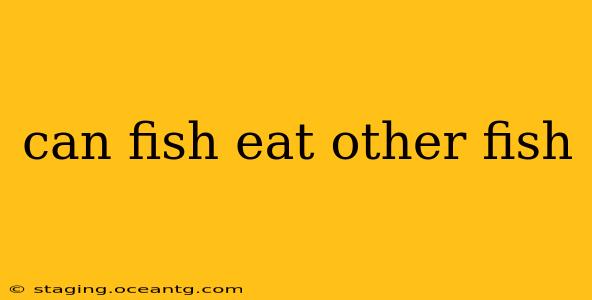Can Fish Eat Other Fish? A Deep Dive into Piscivorous Predators
The short answer is a resounding yes, many fish species eat other fish. This predatory behavior is a fundamental part of aquatic ecosystems, influencing population dynamics and the overall health of the environment. However, the specifics of which fish eat which, and how often, are far more complex than a simple yes or no. Let's explore this fascinating aspect of fish biology in more detail.
What Types of Fish Eat Other Fish?
The world of piscivory (fish-eating) encompasses a vast array of species. Some fish are exclusively piscivorous, meaning their diet consists entirely or almost entirely of other fish. Others are opportunistic feeders, incorporating fish into their diet alongside other food sources like insects, crustaceans, or plants.
Examples of primarily piscivorous fish include:
- Largemouth Bass: A popular game fish known for its voracious appetite for smaller fish.
- Pike: These ambush predators are highly efficient hunters, capable of taking fish considerably larger than themselves.
- Muskellunge: A close relative of the pike, muskies are apex predators in many freshwater systems.
- Tuna: Several tuna species are highly effective pelagic predators that consume large quantities of smaller fish.
- Sharks: Many shark species are apex predators and significant piscivores. Examples include Great White Sharks and Tiger Sharks.
- Barracuda: These fast, aggressive predators often target schools of smaller fish.
This list is by no means exhaustive; countless other fish species actively hunt and consume other fish. The specific diet of a fish species often depends on factors like its size, habitat, and the availability of prey.
What Kind of Fish Do Other Fish Eat?
The answer to this question is equally varied. Predatory fish will typically target fish that are smaller and weaker than themselves. This often means:
- Smaller fish of the same species: Cannibalism is surprisingly common in many fish populations.
- Fish of different species: A predator’s diet is often determined by what's readily available in its environment.
- Sick or injured fish: Predators often target vulnerable individuals, helping to maintain a healthy population by removing weaker members.
- Fish eggs and larvae: Many fish consume eggs and larvae, significantly impacting the reproductive success of other species.
How Do Fish Catch Other Fish?
Piscivorous fish employ a variety of hunting strategies, depending on their morphology and habitat. Some common methods include:
- Ambush predation: Predators like pike and largemouth bass lie in wait, concealed amongst vegetation or other cover, before launching a sudden attack.
- Pursuit predation: Fast-swimming predators like tuna and barracuda chase down their prey.
- Cooperative hunting: Some fish species, such as certain types of groupers, cooperate to herd and capture prey.
Do All Fish Species Eat Other Fish?
No, definitely not. Many fish are herbivores, feeding primarily on plants, algae, and other vegetation. Others are insectivores, consuming insects and other invertebrates. Still, others are omnivores, consuming a mixed diet of plants, animals, and other organic matter. The trophic level (position in the food chain) of a fish greatly dictates its dietary habits.
Are There Any Exceptions to Fish Eating Other Fish?
While many fish are piscivores, there are certainly exceptions. Many small, peaceful species, such as many types of minnows or tetras, are primarily herbivores or insectivores and pose no threat to other fish. Their size and lack of predatory adaptations prevent them from hunting larger prey.
In conclusion, while not all fish eat other fish, piscivory is a widespread and essential aspect of aquatic ecosystems. Understanding the intricate relationships between predator and prey within these systems is crucial to maintaining biodiversity and overall environmental health. The diversity of hunting strategies and the varied diets of fish highlight the complexity and fascination of the underwater world.
